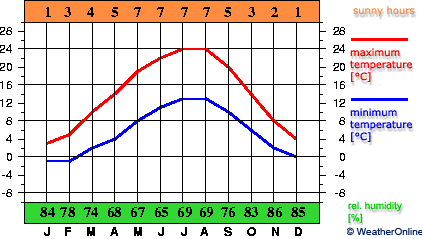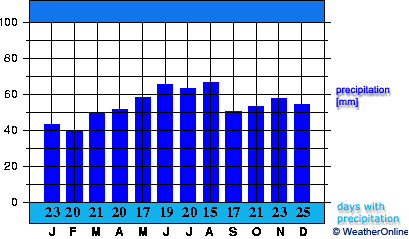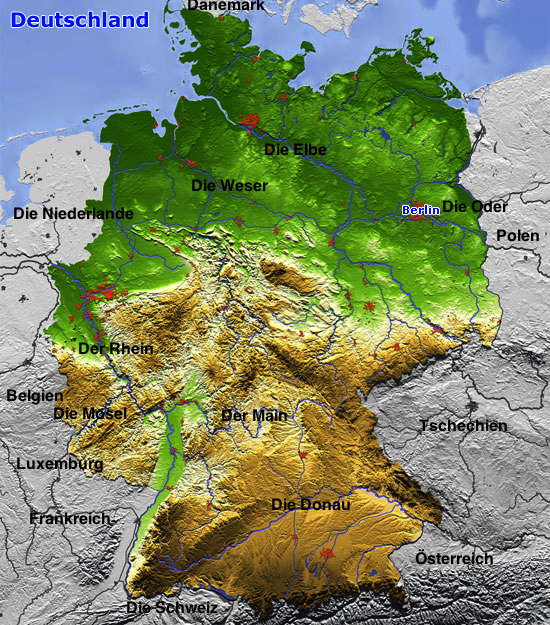| Seite 9 |
Cultural Notes: Climate and GeographyEven though most of Germany is farther north than the United States (Munich in the south of Germany lies just below the Canadian border), Germany's climate is moderate and has generally no longer periods of cold or hot weather.Northern Germany's climate is influenced by the Atlantic Gulf Stream, which brings warmer air from the Caribbean, so that warm summers and mild cloudy winters are common. Usually during the winter the temperatures stay above freezing. Farther inland greater seasonal variations in temperature result in warmer summers and colder winters. During January, the coldest month, the average temperature is about 1.5℃ in the north and about -2℃ in the south. In July, the warmest month, it is cooler in the north than in the south. Much of Austria and in the Alpine regions in the far south of German, and, to a lesser degree, some areas of the Central German Uplands have a so-called mountain climate. This climate is characterized by lower temperatures because of higher altitudes and greater precipitation caused by air becoming moisture-laden as it lifts over higher terrain. An occasional condition in the Alps is called "der Föhn", or warm wind. In this atmospheric condition, warm tropical air is drawn across the Alps and loses moisture on the southern slopes of the mountains. Sometimes these winds can be as strong as gales, and can cause damage, especially in late autumn and winter. Especially in fall and winter strong atlantic low-pressure systems can bring gales and uncomfortable weather with showers, thunderstorms and heavy rain, especially in the western coastal parts and the mountainous regions of Germany; in summer times weaker low pressure systems can cause showery weather, and sometimes even severe thunderstorms. Winters in Germany are generally mild, but can sometimes be harsh with heavy snowfall and temperatures far below zero, especially in the eastern, southern and mountainous regions. When in Germany, always be prepared for rain and it is not unusual to need a sweater even in high summer.


GeographyGermany's central and southern regions have forested hills and mountains cut through by the Danube, Main, and Rhine river valleys; in the deep south are the Alps (die Alpen). Germany's highest mountain is the Zugspitze, located in Bavaria (Bayern), near the ski resort town of Garmisch-Partenkirchen.In the north, the landscape flattens out to a wide plain that stretches to the North Sea (die Nordsee). Between these extremes, Germany is a country of incredible variety. Germany's location at the heart of Europe has shaped its history both for good and bad. It borders nine neighbors (Nachbarländer), more than any other European country: Dänemark, Polen, Tschechien, Österreich, die Schweiz, Frankreich, Luxembourg, Belgien, die Niederlande. Germany's largest wooded area, and its most famous, is in the southwest near the Swiss border. This is the Black Forest (der Schwarzwald), a mountainous region full of pines and fir trees. This forest contains the source of the Danube, one of Europe's longest rivers. Germany enjoys a dense network of navigable rivers. The largest are der Rhein, die Elbe, die Weser, die Oder, der Main, and die Mosel. Find them on the map below. 
Übung 2-9a das Klima, die Geographie
Übung 2-9b. Wortstellungen. Zeitformen. As we have already seen, in simple statements in German, the verb (finite verb) is always second.
But the subject does not have to come right before the verb, as is the case in English. The sentences Das Wetter ist heiß im Sommer or
Im Sommer ist das Wetter heiß are both grammatical and are not different in meaning. Ask your partner what the following people are
doing. Then ask when (wann) they are doing these activities. Begin each answer to the question "wann" with the time expression. Partner A
Partner B
|